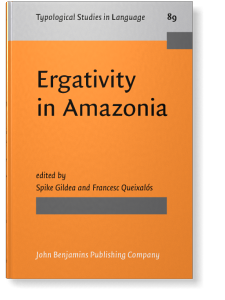Ergativity in Amazonia
Editors
This volume presents a typological/theoretical introduction plus eight papers about ergative alignment in 16 Amazonian languages. All are written by linguists with years of fieldwork and comparative experience in the region, all describe details of the synchronic systems, and several also provide diachronic insight into the evolution of these systems. The five papers in Part I focus on languages from four larger families with ergative patterns primarily in morphology. The typological contribution is in detailed consideration of unusual splits, changes in ergative patterns, and parallels between ergative main clauses and nominalizations. The three papers in Part II discuss genetically isolated languages. Two present dominant ergative patterns in both morphology and syntax, the other a syntactic inverse system that is predominantly ergative in discourse. In each, the authors demonstrate that identification of traditional grammatical relations is problematic. These data will figure in all future typological and theoretical debates about grammatical relations.
[Typological Studies in Language, 89] 2010. v, 319 pp.
Publishing status: Available
© John Benjamins Publishing Company
Table of Contents
-
Manifestations of ergativity in AmazoniaFrancesc Queixalós and Spike Gildea | pp. 1–26
-
Part I. Well-established systems: Morphological ergativity
-
Ergativity in the Mayoruna branch of the Panoan familyDavid W. Fleck | pp. 29–64
-
Ergativity in Shipibo-Konibo, a Panoan language of the UcayaliPilar M. Valenzuela | pp. 65–96
-
How ergative is Cavineña?Antoine Guillaume | pp. 97–120
-
The ergativity effect in Kuikuro (Southern Carib, Brazil)Bruna Franchetto | pp. 121–158
-
Nominative-absolutive: Counter-universal split ergativity in Jê and CaribanSpike Gildea and Flávia Castro Alves | pp. 159–200
-
Part II. Recent diachronic innovations: Syntactic ergativity
-
Ergativity in TrumaiRaquel Guirardello-Damian | pp. 203–234
-
Grammatical relations in Katukina-KanamariFrancesc Queixalós | pp. 235–284
-
The intransitive basis of Movima clause structureKatharina Haude | pp. 285–316
-
Index | pp. 317–320
“This fine collection of papers demonstrates the importance of examining first-hand discourse data to shape current linguistic theory, as each author -- after meticulously describing and discussing ergative patterns in a particular language or language family -- questions or further defines established linguistic categories.
It is great to see more work come out of this highly underdescribed and understudied geographic region and to have collaboration of researchers across the globe. This volume is surely an important addition to typology potentially inspiring further first-hand data-driven typological studies that challenge and refine current definitions of ergativity and of linguistic categories. Furthermore, I welcome the growing interdependent relationship between fieldwork and typology, as evident from this volume, where new data from previously undescribed languages and already existing data equally inform linguistic theory.”
It is great to see more work come out of this highly underdescribed and understudied geographic region and to have collaboration of researchers across the globe. This volume is surely an important addition to typology potentially inspiring further first-hand data-driven typological studies that challenge and refine current definitions of ergativity and of linguistic categories. Furthermore, I welcome the growing interdependent relationship between fieldwork and typology, as evident from this volume, where new data from previously undescribed languages and already existing data equally inform linguistic theory.”
Carmen Jany, California State University, San Bernardino, on Linguist List 22.361, 2010
“This volume is an important addition to the literature on ergativity in the world's languages, providing as it does detailed information on ergativity (both morphological and syntactic) in sixteen Amazonian languages. One appreciates the level of fine descriptive detail given in the articles; this represents the primary contribution of the book.”
William B. McGregor, Aarhus University, in Journal of Linguistics 48: 238-243, 2012.
“This volume is an important addition to the literature on ergativity in the world's languages, providing as it does detailed information on ergativity (both morphological and syntactic) in sixteen Amazonian languages. One appreciates the level of fine descriptive detail given in the articles; this represents the primary contributions of this book.”
William B. McGregor, Aarhus University, in Journal of Linguistics 48: 238-242
Cited by (5)
Cited by five other publications
Dos Santos, Gelsama Mara Ferreira & Bruna Franchetto
McGregor, William B.
2023. Chapter 9. Zero-marking or nothing to mark?. In Reconnecting Form and Meaning [Studies in Language Companion Series, 230], ► pp. 237 ff. 
Queixalós, Francesc
Storto, Luciana
2014. Review of Aikhenvald (2012): The languages of the Amazon. Studies in Language 38:2 ► pp. 427 ff. 
This list is based on CrossRef data as of 20 july 2024. Please note that it may not be complete. Sources presented here have been supplied by the respective publishers. Any errors therein should be reported to them.
Subjects
Main BIC Subject
CFK: Grammar, syntax
Main BISAC Subject
LAN009000: LANGUAGE ARTS & DISCIPLINES / Linguistics / General
